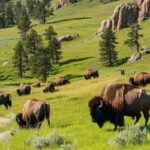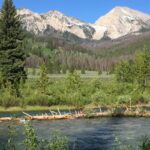Canyonlands National Park is one of the most captivating and remote landscapes in the United States. Located in southeastern Utah, it offers stunning vistas, dramatic canyons, and towering mesas that lure thousands of adventurers each year. However, beneath the beauty of this rugged wilderness lie hidden dangers that every visitor should be aware of before venturing into the park. Understanding these hazards can make the difference between a memorable adventure and a dangerous ordeal.
The Challenge of Extreme Heat
Canyonlands is part of the arid desert environment of southern Utah, and one of the most serious threats to visitors is the extreme heat, especially during the summer months. Temperatures often soar above 100°F (38°C), and the dry air can rapidly dehydrate hikers without them realizing it. Dehydration, heat exhaustion, and heat stroke are genuine risks that can escalate quickly in such conditions.
To mitigate the risk of heat-related illness, it’s crucial to bring plenty of water—at least one gallon per person per day, as recommended by park authorities. Staying hydrated is not just a summer precaution; even during cooler months, the desert air can cause rapid moisture loss. Additionally, loose-fitting, light-colored clothing, a wide-brimmed hat, and sunscreen are essential for protection from the sun. Timing your hikes for early morning or late evening, when temperatures are lower, can also reduce the risk.
Flash Floods and Unpredictable Weather
Another hidden danger in Canyonlands National Park comes from its unpredictable weather. While the desert may seem dry and desolate, the region is prone to sudden storms, particularly in the summer. These storms can trigger flash floods, especially in narrow canyons and dry riverbeds known as washes. Flash floods can turn an otherwise dry canyon into a raging torrent of water in minutes, making it incredibly dangerous for hikers who are unprepared.
The park’s rugged terrain and isolated location make it difficult to escape such natural disasters quickly. Checking weather forecasts before heading out and avoiding low-lying areas during rainstorms is critical for safety. In addition, the National Park Service advises visitors to familiarize themselves with the signs of an impending flash flood, such as rapidly darkening skies or distant thunder.
The Maze: A Test of Self-Sufficiency
Among the most remote and least visited areas of Canyonlands is a district aptly named “The Maze.” Known for its complex network of canyons, The Maze is notorious for its difficult access and extreme isolation. Unlike other parts of the park, reaching The Maze often requires a high-clearance, four-wheel-drive vehicle, and the journey can take hours. Once inside, trails are poorly marked, and many routes require climbing over slickrock and negotiating steep drop-offs.
Navigating The Maze is not for the faint of heart or inexperienced adventurer. GPS units often fail due to the rugged topography, and it’s easy to get lost in the labyrinth of canyons. Because the area is so remote, rescue operations can take days, and cell phone service is almost nonexistent. Visitors must be prepared for complete self-sufficiency, bringing enough food, water, and emergency supplies for several days.
Water is particularly scarce in The Maze, with very few reliable sources. Carrying a topographic map and knowing where the few water springs are located is vital for survival. It’s recommended that hikers carry at least four liters of water per person per day, but more may be necessary during hotter months.
Wildlife Encounters: Small But Dangerous
Canyonlands is home to a variety of wildlife, some of which pose serious dangers to visitors. While black bears are rare, they have been spotted in the park, particularly in the Needles district near Salt Creek Canyon. Hikers in bear-prone areas are advised to use bear-proof containers for food storage and be aware of their surroundings.
More common, however, are smaller but equally dangerous animals. The desert is home to venomous creatures like rattlesnakes, scorpions, and black widow spiders. While rattlesnakes generally avoid humans, encounters can happen, especially when stepping over rocks or bushes. A bite from a rattlesnake or black widow spider requires immediate medical attention, though such medical help may be hours away in the remote backcountry.
Additionally, the hantavirus, which is carried by rodents, can be a concern in some areas of the park. It’s essential to avoid contact with rodent droppings and ensure that food and camping gear are stored properly.
Cliff Edges and Loose Rock: The Danger of Falls
The dramatic cliffs and mesas that define Canyonlands are a significant part of its allure, but they also represent one of the most serious dangers. The park’s high, exposed ridges and cliffs pose a real risk of falls, especially when the rock is loose or the ground is wet from recent rain. The slickrock, while easier to ascend, can be treacherous on the descent.
Visitors should be particularly cautious around cliff edges and avoid venturing too close, especially when taking photographs or enjoying the views. Falls from cliffs in national parks have resulted in serious injuries and fatalities. It’s always better to enjoy the scenery from a safe distance.
Isolation and Slow Rescue Response
One of the overarching dangers in Canyonlands stems from its isolation. Many areas of the park, including The Maze, are hours away from the nearest ranger station or medical facility. If an emergency arises, help may not arrive for several hours, or even days, depending on the location.
The rugged terrain, lack of cellular service, and long distances between major areas in the park can complicate rescue operations. Visitors are encouraged to leave a detailed itinerary with someone outside the park and check in with rangers when possible. Having a satellite communication device or personal locator beacon can also be a lifesaver in the event of an emergency.
Conclusion
Canyonlands National Park offers some of the most breathtaking scenery in the United States, but its rugged beauty comes with hidden dangers that should not be underestimated. From extreme heat and flash floods to remote areas like The Maze, where self-sufficiency is essential, visitors must be well-prepared before embarking on their adventure. Understanding these risks and taking appropriate precautions can ensure a safe and enjoyable visit to this wild, awe-inspiring landscape.
Always remember that nature, while beautiful, can also be unforgiving. Respecting the environment and preparing for its challenges will allow you to experience the wonders of Canyonlands while minimizing the risks.






